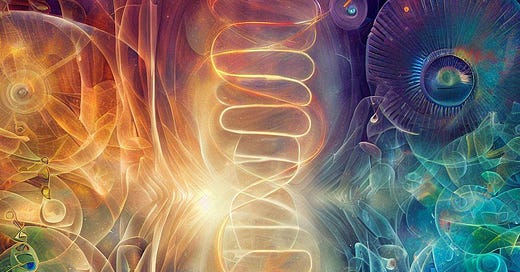Transcending Our Hidden Inheritance: Epigenetics, Vasanas and Samskaras.
How spiritual practices can rewrite destructive subconscious patterns.
Epigenetics studies how the environment and life experiences can modify gene activity, and these modifications can be passed on to offspring. This mechanism of inherited acquired traits aligns with the insight from Vedantic philosophy that the experiences of ancestors can influence future generations. Epigenetics provides a scientific explanation for this concept from ancient wisdom.
Vasanas are the subtle desires or tendencies that arise from the samskaras. They are the hidden marks in the mind that result from cravings, dislikes, and routines. Vasanas foster natural propensities and customary actions.
Samskaras are the profound mental structures determined by previous deeds. They are the subconscious imprints that mould an individual’s character, originating from both this and past lives. Samskaras affect a person’s traits, outlooks and possibilities.
There are significant parallels between these Vedantic constructs and modern epigenetic paradigms. Vasanas appear to mirror how lived experience shapes energetic patterns that persist over time. Samskaras evoke how thoughts, emotions and actions leave deep imprints on the individual and collective psyche.
Vedantic practices of Shravana, Manana and Nididhyasana offer concrete means to transcend limiting inherited energetic and psychic patterns. Shravana, or in-depth study of spiritual texts and teachings, sheds light on the true nature of the Self and dissolves false identifications. Manana is reflection and reasoning that internalizes knowledge, detaching from negative vasanas. Nididhyasana, or profound contemplation and absorption of spiritual knowledge, integrates this wisdom into one's being, inaugurating positive new samskaras.
The key points about Nididhyasana:
It goes beyond intellectual study (shravana) and reflection (manana) to integrate self-knowledge through conscious absorption and contemplation.
It is an advanced stage of meditation that internalizes wisdom by focusing single points on the teachings and their relevance to one's inner experience.
It leads to full integration and embodiment of self-knowledge in one's mind, heart and consciousness.
This profound assimilation of spiritual wisdom transforms one's mental patterns and inaugurates positive samskaras aligned with the truth.
For instance, meditation induces epigenetic changes that enhance anti-inflammatory genes and reduce pro-inflammatory gene expression. This bolsters resilience to stress at the molecular level. Also, meditation structures brain areas linked to emotional regulation, forging new neural circuits of equanimity. These effects can mitigate engrained anxious vasanas and inaugurate samskaras of mental and emotional stability.
Likewise, pranayama yoga acts on the sympathetic and parasympathetic nervous systems, balancing neuro-endocrine rhythms underlying reactivity and stress. Yoga and meditation modulate the HPA axis, which underlies many inherited anxious and depressive predispositions. Devotional practices like chanting mantras raise oxytocin, dopamine, endorphins and other neurotransmitters that induce well-being, countering vasanas linked to sadness.
Moreover, the Vedantic perspective emphasizes disidentifying from limiting psycho-energetic patterns. Remembering one's essential nature as Atman, one unlocks the self-centeredness that feeds vasanas and enacts negative samskaras. This "disidentification" allows one to respond to inherited predispositions with conscious wisdom, not reactivity. By cultivating qualities like compassion, equanimity, and service, one becomes inwardly liberated from trans-generational conditioning.
As with epigenetic interventions, targeted spiritual sadhana can reprogram deep energetic and psychic dynamics in an evolutionary direction. In this way, inherited patterns that limit human potential can be transformed. Neuroscience itself confirms the considerable neuroplasticity that makes such inner regeneration possible.
Neuroplasticity refers to the brain's ability to structurally and functionally change and adapt in response to experience. Neural networks can reorganize their connections and behaviour through the growth of new synapses, alteration of conduction patterns, and neurogenesis even into adulthood. These neuroplastic capacities make the brain open to positive reshaping.
Many studies verify the neuroplastic effects of spiritual practices like meditation. MRI scans reveal that meditation strengthens neuronal structures related to attention, compassion, and resilience. Electroencephalography (EEG) shows meditation induces synchrony between the brain's hemispheres. Long-term meditators display structural enlargements in regions linked to meta-awareness, introspection and present-moment focus. Mindfulness and compassion practices also expand prefrontal cortex areas associated with higher-order functions like ethics and emotional regulation.
On the biochemical level, meditation and yoga have been found to optimize neurotransmitters, neurotrophins and neuropeptides critical for cognitive flexibility and positive mood. In essence, contemplative neuroscience confirms that dedicated inner work can trigger neuroplastic processes for effecting psychological, emotional and spiritual growth. Our innate potential for awareness and transformation can sculpt the brain's malleable architecture in salutary ways through experiential practices.
In conclusion, the integrative perspectives of Vedanta and epigenetics illuminate that we are more than just passive products of our genetic and karmic pasts. Our inherent neuroplasticity allows conscious redirection of our psycho-energetic patterns toward higher goals. Daily practices that train awareness, redirect emotions, and serve others can progressively untie the knots of biological and psychic conditioning rooted in the depths of consciousness. By choosing wisely our thoughts, words and actions - by embracing sadhana - we take responsibility for who we become, beyond predictive algorithms of heredity. In this way, the convergence of human wisdom and science reaffirms our capacity for self-realization and liberation even from the so-called prison of past conditioning. The keys to unlock our dormant potential for transfiguration exist within us, waiting to be seized.
I have woven tales to share, for any who care to read them. My books await you on Google Books. Check also my stories on Medium.com.




